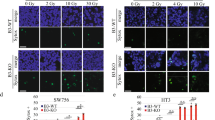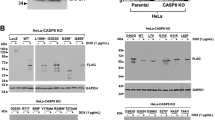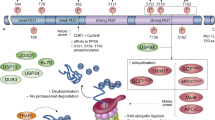Abstract
Caspase-3 is a member of the cysteine protease family, which plays a crucial role in apoptotic pathways by cleaving a variety of key cellular proteins. Caspase-3 can be activated by diverse death-inducing signals, including the chemotherapeutic agents. The purpose of this study was to determine the levels of caspase-3 expression in breast tumor samples and to determine whether alterations in its expression can affect their ability to undergo apoptosis. Primary breast tumor and normal breast parenchyma samples were obtained from patients undergoing breast surgery and the expression of caspases-3 was studied. Similarly, normal mammary epithelial cells and several established mammary cancer cell lines were studied for caspases-3 expression by reverse transcriptase-polymerase chain reaction, Northern blot analysis, and Western blot analysis. Approximately 75% of the tumor as well as morphologically normal peritumoral tissue samples lacked the caspase-3 transcript and caspase-3 protein expression. In addition, the caspases-3 mRNA levels in commercially available total RNA samples from breast, ovarian, and cervical tumors were either undetectable (breast and cervical) or substantially decreased (ovarian). Despite the complete loss of caspase-3, the expression levels of other caspases, such as caspase-8 and caspase-9, were normal in all of the tumor samples studied. The sensitivity of caspase-3-deficient breast cancer (MCF-7) cells to undergo apoptosis in response to doxorubicin and other apoptotic stimuli could be augmented by reconstituting caspase-3 expression. These results suggest that the loss of caspases-3 expression may represent an important cell survival mechanism in breast cancer patients.
This is a preview of subscription content, access via your institution
Access options
Subscribe to this journal
Receive 50 print issues and online access
$259.00 per year
only $5.18 per issue
Buy this article
- Purchase on Springer Link
- Instant access to full article PDF
Prices may be subject to local taxes which are calculated during checkout






Similar content being viewed by others
References
Ahmad M, Srinivasula M, Hegde R, Mukattash R, Fernandes-Alnemri T, Elnemari ES . 1998 Cancer Res. 58: 5201–5205
Bagasara O, Seshamma T, Pomerantz RJ . 1993 J. Immunol. Methods 158: 131–145
Cande C, Cohen I, Daugas E, Ravagnan L, Larochette N, Namzami N, Kroemer G . 2002 Biochimie 84: 215–222
Chen X, Lowe M, Herliczek T, Hall MJ, Danes C, Lawreance DA, Keyomarsi K . 2000 J. Natl. Cancer Inst. 92: 1999–2008
Chomczynski P . 1993 Biotechnique 15: 532–536
Clynes M, Daly C, NicAmhlahoibh R, Cronin D, Elliott C, O'Connor R, O'Doherty T, Conolly L, Howlett A, Scanlon K . 1998 Crit. Rev. Oncol. Hematol. 28: 181–205
Cryns V, Yuan J . 1998 Genes Dev. 12: 1551–1570
Devarajan E, Chen J, Multani AS, Pathak S, Sahin AA, Mehta K . 2002 Int. J. Oncol. 20: 913–920
Eck-Enriquez K, Kiefer TL, Spriggs LL, Hill SM . 2000 Breast Cancer Res. Treat. 61: 229–239
Eckhart L, Ban J, Fischer H, Tschachler E . 2000 Biochem. Biophys. Res. Comm. 277: 655–659
Enari M, Talanian RV, Wong WW, Nagata S . 1996 Nature 380: 723–726
Evan G, Littlewood T . 1998 Science 282: 1317–1321
Friedrich K, Weider T, Haefen CV, Radetzki S, Jenicke R, Schulze-Osthoff K, Dorken B, Daniel PT . 2001 Oncogene 20: 2749–2760
Guo Y, Kyprianou N . 1999 Cancer Res 59: 1366–1371
Hanahan D, Weinberg RA . 2000 Cell 100: 57–70
Haidar MA, Manshouri T, Keating MJ, Kantarjian HM, Freireich EJ, Mehta K, Albitar M . 2000 Int. J. Oncol. 16: 561–565
Harris CC . 1996 Carcinogenesis 17: 1187–1198
Hasegawa J, Kamad S, Kamiike W, Shimizu S, Imazu T, Matsuda H, Tsujimoto Y . 1996 Cancer Res. 56: 1713–1718
Hickman JA . 1996 Eur. J. Cancer 32: 921–926
Huang TH, Perry MR, Laux DE . 1999 Hum. Mol. Genet. 8: 459–470
Huang Y, Shin NH, Sun Y, Wang KK . 2001 Biochem. Biophys. Res. Commun. 283: 762–769
Janicke RU, Sprengart ML, Wati MR, Porter AG . 1998 J. Biol. Chem. 273: 9357–9360
Johnstone RW, Ruefli AA, Lowe SW . 2002 Cell 108: 153–164
Kerr JF, Wyllie AH, Currie AR . 1972 Br. J. Cancer 26: 239–257
Kuida K, Zheng TS, Na S, Kuan C, Yang D, Karasuyama H, Rakic P, Flavell RA . 1996 Nature 384: 368–372
Liang Y, Yan C, Schor NF . 2001 Oncogene 20: 6570–6578
Martin SJ, Green DR . 1995 Crit. Rev. Oncol. Hematol. 18: 137–153
Nakopoulou L, Alexandrou P, Stefanaki K, Panayotopoulou E, Lazaris AC, Davaris PS . 2001 Pathobiology 69: 266–273
Nicholson DW . 1999 Cell Death Differ. 6: 1028–1042
Pirnia F, Breuleux M, Schneider E, Hochmeister M, Bates S, Marti A, Hotz MA, Betticher DC, Borner MM . 2000 J. Nat. Cancer Inst. 92: 1535–1536
Salvesen GS, Dixit VM . 1997 Cell 91: 443–446
Silke J, Ekert PG, Day CL, Hawkins CJ, Baca M, Chew J, Pakusch M, Verhagan AM, Vaux DL . 2001 EMBO J. 20: 3114–3123
Soengas MS, Capodieci P, Polsky D, Mora J, Esteller M, Opitz-Araya X, McCombie R, Herman JG, Gerald WL, Lazebnik YA, Cordon-Cardo C, Lowe SW . 2001 Nature 409: 207–211
Teitz T, Wei T, Valentine MB, Vanin EF, Grenet J, Valentine VA, Behm FG, Look AT, Lahti JM, Kidd VJ . 2000 Nat. Med. 6: 529–535
Thorneberry NA, Lazebnik Y . 1998 Science 281: 1312–1316
Ueki T, Takeuchi T, Nishimatsu H, Kajiwars T, Moriyama N, Narita Y, Kawabe K, Ukei K, Kitamura T . 2001 Int. J. Cancer 91: 673–679
Wallace-Brodeur RR, Lowe SW . 1999 Cell. Mol. Life Sci. 55: 64–75
Winter RN, Kramer A, Borkowski A, Kyprianou N . 2001 Cancer Res 61: 1227–1232
Yang XH, Sladek TL, Liu X, Butler BR, Froelich CJ, Thor AD . 2001 Cancer Res. 61: 348–354
Yuan Y, Mendez R, Sahin A, Dai JL . 2001 Cancer Res. 61: 5558–5561
Acknowledgements
This work was supported by a grant from the US Department of Defense (DAMD17-01-1-0645) to K Mehta and by American Health Assistance Foundation to N Aggarwal. We thank Drs J Dai and K Keyomarsi for providing cell lines and Ms Mariann Crapanzano for the editorial help.
Author information
Authors and Affiliations
Corresponding author
Rights and permissions
About this article
Cite this article
Devarajan, E., Sahin, A., Chen, J. et al. Down-regulation of caspase 3 in breast cancer: a possible mechanism for chemoresistance. Oncogene 21, 8843–8851 (2002). https://doi.org/10.1038/sj.onc.1206044
Received:
Revised:
Accepted:
Published:
Issue Date:
DOI: https://doi.org/10.1038/sj.onc.1206044
Keywords
This article is cited by
-
The effect of the anti-leukemia inhibitory factor on the immune system in the Balb/c mice bearing breast cancer induced with 4T1 cells
European Journal of Medical Research (2023)
-
Anti-proliferative activity of Artemisia marschalliana on cancerous cell lines
BMC Complementary Medicine and Therapies (2023)
-
Eta polycaprolactone (ε-PCL) implants appear to cause a partial differentiation of breast cancer lung metastasis in a murine model
BMC Cancer (2023)
-
Identification of N-(4-acetyl-4,5-dihydro-5-(7,8,9-substituted-tetrazolo[1,5-a]-quinolin-4-yl)-1,3,4-thiadiazol-2-yl) acetamide derivatives as potential caspase-3 inhibitors via detailed computational investigations
Structural Chemistry (2023)
-
Concomitant effects of paclitaxel and celecoxib on genes involved in apoptosis of triple-negative metastatic breast cancer cells
Medical Oncology (2023)



